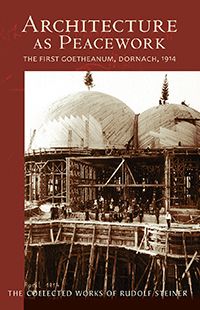Architecture as Peacework: The First Goetheanum, Dornach, 1914 (CW 287)
SKU SB9781621480990
$33.50
5 lectures, Dornach, Switzerland, October 10-25, 1914 (CW 287), Translated by Frederick Amrine, Introduction by John Kettle
5 available
1
Save this product for later
Architecture as Peacework: The First Goetheanum, Dornach, 1914 (CW 287)
Product Details
Author: Rudolf Steiner, Translated by Frederick Amrine, Introduction by John Kettle
,
196 pp.
,6" x 9"
,Illustrations: 15 black and white
,SteinerBooks
,
Paperback
,Published: December 2016
,978-1-62148-099-0
,
5 lectures, Dornach, Switzerland, October 10-25, 1914 (CW 287)
,
"We need to create an energetic culture of peace-not idle talk of peace, but the real peace that can arise only out of a concrete, mutual understanding of the various individual cultures.",-Rudolf Steiner (lecture 2)
,
At the outbreak of World War I in August 1914, the construction of the singular architectural masterwork that would later be called the Goetheanum (and, later still, the First Goetheanum) was already well under way on a hill just above the village of Dornach in neutral Switzerland. There, a small international community had gathered over the previous year to take part in this utterly unique artistic building project under Rudolf Steiner's direction. When the war began, the mood and day-to-day life of Europe was instantly changed, no less so amid this ad hoc spiritual and artistic community: artillery could be heard in the distance; many were called back to their respective countries for armed service; and tensions between individuals of various nationalities who remained in Dornach were very soon in evidence.
,
This is the immediate background to these evening lectures given in the woodworking building next to the construction site in Dornach just two months after the start of the war. Never announcing his intentions, and using the metamorphosing forms of the hand-sculpted wooden architraves resting on the columns inside the building itself as illustration, Steiner embarked on a convincing and heartfelt appreciation, even celebration, of the uniquely beautiful qualities of the various European cultures then at war.
,
These lectures were given at a very specific time and place, to a very specific audience, with a very clear intention-to cultivate in the midst of violence and aggression not just tolerance for other peoples and cultures, but also love and sincere appreciation. Such intentions are still needed today-thus, the continued relevance of these lectures. The Russian writer Andrei Bely was present at these talks, and later commented on them:
,
,
196 pp.
,6" x 9"
,Illustrations: 15 black and white
,SteinerBooks
,
Paperback
,Published: December 2016
,978-1-62148-099-0
,
5 lectures, Dornach, Switzerland, October 10-25, 1914 (CW 287)
,
"We need to create an energetic culture of peace-not idle talk of peace, but the real peace that can arise only out of a concrete, mutual understanding of the various individual cultures.",-Rudolf Steiner (lecture 2)
,
At the outbreak of World War I in August 1914, the construction of the singular architectural masterwork that would later be called the Goetheanum (and, later still, the First Goetheanum) was already well under way on a hill just above the village of Dornach in neutral Switzerland. There, a small international community had gathered over the previous year to take part in this utterly unique artistic building project under Rudolf Steiner's direction. When the war began, the mood and day-to-day life of Europe was instantly changed, no less so amid this ad hoc spiritual and artistic community: artillery could be heard in the distance; many were called back to their respective countries for armed service; and tensions between individuals of various nationalities who remained in Dornach were very soon in evidence.
,
This is the immediate background to these evening lectures given in the woodworking building next to the construction site in Dornach just two months after the start of the war. Never announcing his intentions, and using the metamorphosing forms of the hand-sculpted wooden architraves resting on the columns inside the building itself as illustration, Steiner embarked on a convincing and heartfelt appreciation, even celebration, of the uniquely beautiful qualities of the various European cultures then at war.
,
These lectures were given at a very specific time and place, to a very specific audience, with a very clear intention-to cultivate in the midst of violence and aggression not just tolerance for other peoples and cultures, but also love and sincere appreciation. Such intentions are still needed today-thus, the continued relevance of these lectures. The Russian writer Andrei Bely was present at these talks, and later commented on them:
,
-
,
- "In light of his words we looked at each other with new eyes, the oppressive mood was transformed; other infections broke out later but the national fever was overcome once and for all. The members of the belligerent nations lived in peace from then on." ,
,
Photographs and Drawings
,Preceding Lecture One:
,1. Rudolf Steiner at the building site
,2. First Goetheanum, from the south
,3. First Goetheanum, under construction, February 1914
,4. Detail of the interior construction of the large dome, June 1914
,Following Lecture Five:
,5. Preparation and carving work in the carpenter's workshop, May 1914
,6. Carving work on the curvatures between the columns and the internal wall
,7. Carving the capitals in the concrete underbody of the building, April 1914
,8. Architrave of the large dome, model
,9. Architrave of the large dome, status of the carving work, October 1914
,10. ltarge dome space of the first Goetheanum: seventh to fourth column
,11. ltarge dome space of the first Goetheanum: fourth to first column
,12. Construction workers assembling the capitals
,
,
This book is volume 287 in the Collected Works (CW) of Rudolf Steiner, published by SteinerBooks, 2017. The translation is based on the second German edition of GA 287, Der Dornacher Bau als Wahrzeichen geschichtlichen Werdens und ku‚☻nstlerischer Umwandlungsimpulse, published by Rudolf Steiner Verlag, Dornach, Switzerland, 1985. Cover Image:The Goetheanum during construction work, April 1914 (Dokumentation am Goetheanum).
,
Display prices in:CAD

